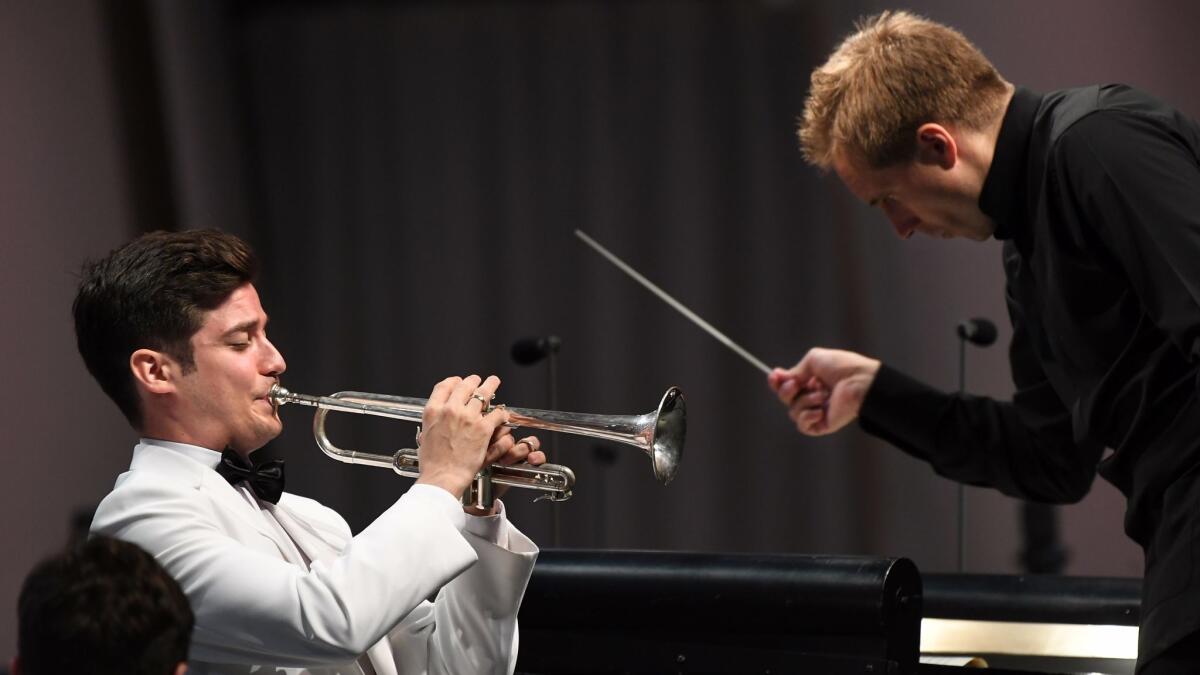Review: Vasily Petrenko’s Hollywood Bowl show was a mixed bag benefited by the venue’s audiovisual system

- Share via
It was a little thing. Still, the more information explodes, the more we turn to understanding big events through the seemingly small. We follow, say, the progress of modern civilization through the development of the pencil, or we trace minuscule currents caused by smashing a gnat on Santa Monica Boulevard to the hot African winds currently plaguing Rome.
On Tuesday night, Vasily Petrenko walked onto the Hollywood Bowl stage and, as I’ve never seen before at the Bowl, led the national anthem while standing among the Los Angeles Philharmonic players, before mounting the podium to begin the program. One way to read this appealing gesture was as Russian conductor showing cultural camaraderie with an American orchestra. Another might be as self-effacing effort to ease into a concert designed by Mirga Grazinyte-Tyla, the originally scheduled conductor who canceled a day earlier. An unobtrusive performance of “Prelude to the Afternoon of a Faun” followed.
When Petrenko returned to the Bowl on Thursday for his own scheduled evening with the L.A. Phil, he marched right up to the podium to conduct the anthem. This time he confidently launched into a dashing “Don Juan,” Strauss’ tone poem. It was sharply played, dramatically shaped.
He had reason to be buoyed. The announcement earlier in the day of the Gramophone Awards shortlist included Petrenko’s recording of Tchaikovsky’s Violin Concerto with Augustin Hadelich. Thursday’s concert, moreover, was advertised in celebratory terms: “Sound the Trumpet!”
It featured the debut of 25-year-old Hungarian soloist Tamás Pálfalvi in Hummel’s alluring Trumpet Concerto in E-flat. Twenty-five was the magic number. Strauss was 25 when he wrote “Don Juan,” as was Hummel when he wrote his concerto. Both pieces proudly proclaim: Here I come.
Pálfalvi’s own proclamation came two years ago with his venturesome first recording, “Agitato,” in which he pairs Baroque music with striking contemporary pieces and reveals himself to be a young musician with an uncommon combination of elegance and daring.
I have no explanation why this did not, then, turn out to be an auspicious debut. Maybe the concerto, written around the time Beethoven was working on his “Eroica” Symphony but traffics instead on early 19th century pleasantries, was the wrong work for Pálfalvi. And for Petrenko, who began the concerto without much muscle.
The solo playing was smooth and measured. Pálfalvi’s breath control is such you could hardly tell he was breathing, watching him on the video monitors. But he failed to make the music breathe. A major missed opportunity was for a breathtaking encore. “Agitato” includes exactly the right one, the spellbinding six-minute trumpet solo, “Kryl” by Robert Erickson, the influential Southern California composer whose remarkable music has been inexplicably neglected in the two decades since his death. That alone is reason to get “Agitato.”
Brahms’ First Symphony, after intermission, benefited from some of the same Petrenko attributes as “Don Juan.” It was a finely chiseled reading with a rhythmic edge. Textures were kept clear. Phrases were well shaped. None of this added particular personality to the interpretation, but only so much can be expected when for most Bowl concerts there is rarely rehearsal time for anything more than a quick run-through of a program.
In other ways, though, the Bowl cooperated. The sound system keeps getting better, and on this night — possibly helped by heavy warm and humid air along with a considerable number of empty seats — the amplification produced a noticeable reverberation that tricked a listener into thinking the amphitheater a great acoustic space.
It has taken me a long time for me to make peace with the video screens, but they too proved invaluable for the Brahms. Focusing on individual players can be plenty annoying, the camera operators commanding your attention where they choose. But I’m beginning to sense that video could be changing the character of the orchestra mostly for the good.
The musicians know they are being watched. They have to look like they care (which the New York Philharmonic musicians didn’t have to do, and showed it, at an outdoor concert without video in Santa Barbara on Monday night). The screens encourage relating to the audience, and that can translate into performances that relate.
For some reason, Petrenko never quite got the propulsion he seemed to strive for, although close-ups showed him intent on molding expression with every gesture. Instead it was a performance highlighted by other — and little — things, a line here or there given a special emphasis by a player.
One who stood out was associate clarinetist Burt Hara. However nice the minor clarinet solos in the Brahms may be, they hardly make or break a performance of the symphony. Yet watching Hara in close-up, as he molds a line with his body in such a way that both physically and musically stands out while at the same time feels entirely integrated with the ensemble at large, can be an excellent way to draw a listener in.
The Bowl’s audiovisual business rarely works so well as it did here. All the elements have to be aligned on a summer’s night, and don’t necessarily expect them to be the next time. Still, attention to details, to the little things, can make all the difference. And when it does, even Brahms — who we could be quite sure would have hated the Hollywood Bowl — might have puffed contentedly on his cigar Thursday during this performance were he allowed in with it.
More to Read
The biggest entertainment stories
Get our big stories about Hollywood, film, television, music, arts, culture and more right in your inbox as soon as they publish.
You may occasionally receive promotional content from the Los Angeles Times.











